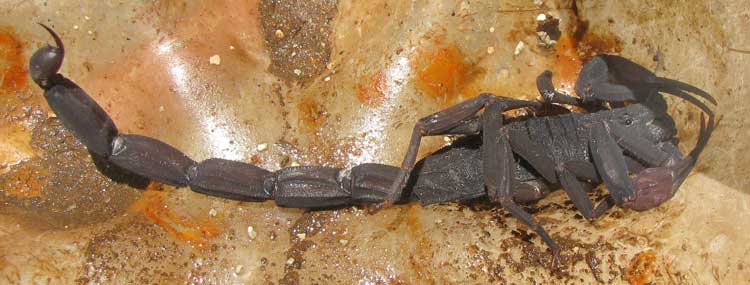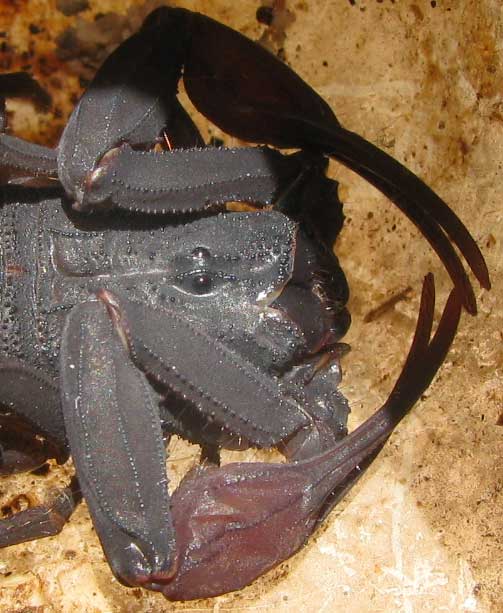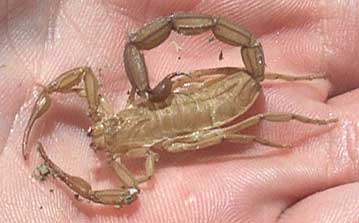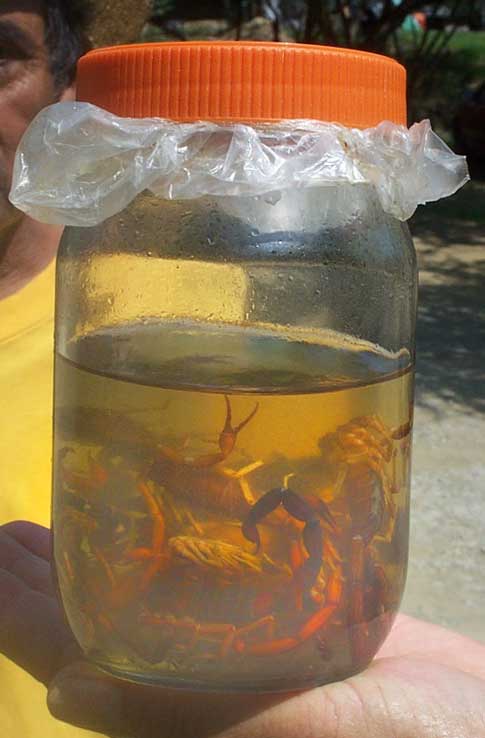Excerpts from Jim Conrad's
Naturalist Newsletter

from the June 6, 2010 Newsletter issued from Hacienda Chichen Resort beside Chichén Itzá Ruins, central Yucatán, MÉXICO
SCORPION STINGS FOR RHEUMATISM
Alex walked into the computer room carrying in his hand the bottom half of a plastic, liter-size Coke bottle that'd been used for cleaning paintbrushes. Inside the container was the 2.4-inch-long (6 cm), black scorpion shown above. In Florida where this scorpion species also occurs it's known as the Florida Bark Scorpion, the Brown Bark Scorpion and the Slenderbrown Scorpion. It's CENTRUROIDES GRACILIS.
When Alex made no signs of offering the critter to me for photographing I asked him what he planned to do with it. Turns out that he was taking it home to someone with bad rheumatism in his knee, with I assume to be arthritis, and have the scorpion sting the knee to ease the pain. "It hurts at first, like a wasp sting," Alex said, "but in the long run it helps with the rheumatism."
I asked why honeybees weren't used, which I've read about, and he said that they're also effective, but not as good as a scorpion.
While the scorpion was handy I took a close-up of the head area nicely showing the eyes atop the head. It's below:

Besides those two eyes atop the head most species bear two to five pairs of eyes along the front corners of the head. Still, they don't seem to see well and rely mostly on their sense of touch.
from the August 20, 2007 Newsletter issued from Sierra Gorda Biosphere Reserve, QUERÉTARO, MÉXICO
SCORPION EXUVIA
Scorpions, like spiders, have "outside skeletons," or exoskeletons, so as they grow they must molt one husk after the other, the molting process being known as "ecdysis." The molted exoskeleton is called an "exuvia" (plural exuviae). So, the other day, atop the switch that opens the gate, which several of us grope for each night to let in or out those without keys, I found the neat little scorpion exuvia shown below:

I'm guessing that this is the exuvia of the same species I profiled in the July 6th Newsletter, CENTRUROIDES GRACILIS, known as the Slender Brown Scorpion or Florida Bark Scorpion, and whose portrait resides at the top of this page.
An interesting feature of that exuvia is that it bears what appears to be an intact stinger, or "telson." The handlens shows a perfectly preserved stinger, but I assume that it's empty of the glands producing venom. Scorpions typically require between five and seven molts to reach maturity.
While confirming the above fancy scorpion terms I learned that most scorpions are slightly fluorescent, something discovered by geologists in Arizona in the 1940s. In the 1970s only about 600 scorpion species were known to science but now over 1520 have been named, thanks mostly to researchers knowing to look for new species at night using "UV flashlights."
from the August 17, 2007 Newsletter issued from Sierra Gorda Biosphere Reserve, QUERÉTARO, MÉXICO
MEDICINAL SCORPIONS

Wednesday my student Lupita brought me a jar of scorpions collected in her house. They're shown above.
That's about two years of scorpions preserved in alcohol. The collection reflects more than Lupita's antipathy for the arachnids; the jar's contents, she assures me, are medicinal.
Lupita says that insect bites stop hurting and itching when scorpion-alcohol is rubbed on them. Old folks tell her that the tincture also works on joints sore with arthritis but she doesn't have arthritis so she isn't sure about that.
from the March 20, 2016 Newsletter issued from Hacienda Chichen Resort beside Chichén Itzá Ruins, central Yucatán, MÉXICO
STUNG BY A SCORPION
At 4AM I lifted the mosquito net, slipped from beneath it, felt the hut's pleasantly cool dust beneath my feet, and two steps later felt a sharp, burning pain in my right foot. I'd been stung by a scorpion, my first time. Moreover, the scorpion seemed to have climbed atop the foot, though the sting hurt so that I couldn't tell whether he was still stinging. Involuntarily I hopped and stomped, and I guess that that shook him off because when finally the flashlight illuminated things, he was gone. I never saw him, which proved to be frustrating, for everyone here, when you tell them you've been stung by a scorpion, asks you which kind it was. There are big ones and little ones.
I've talked to people who had been stung, so I knew that it wasn't serious. People here regard scorpion stings with about the same awe as they do wasp stings: Very unpleasant, but nothing to get upset about. Everyone gets stung, at least if you're out doing interesting things in interesting places.
Therefore, I then tied on my jogging shoes and set off running down the road. After about five minutes I felt a little nauseous, thought I might have to heave a bit along the road, but I kept running and eventually it passed. Also, my mouth felt a little cottony, and my tongue a bit numb, but that passed, too.
Later that day when I proudly told my Maya friends in the restaurant about the sting, they showed no concern at all, but each one in turn asked if my tongue had swelled and got numb so I couldn't talk. That seems to be what the Maya focus on, the effect on the tongue, because that's what's special about a scorpion sting. All kinds of mediocre events can cause you to hurt, but it's just the scorpion that makes your tongue swell. I sort of wished that my tongue had become more numb, but it didn't. I guess my sting must have been a half-hearted one.
I'm glad that upon being stung I didn't go directly to the Internet looking up information about it. Later I did check it out and in print the sting seems more hair-raising than I'd experienced. Speaking about scorpion venom, Vera Petricevich in her 2010 article entitled "Scorpion Venom and the Inflammatory Response" writes:
"These venoms are associated with high morbility and mortality, especially among children. Victims of envenoming by a scorpion suffer a variety of pathologies, involving mainly both sympathetic and parasympathetic stimulation as well as central manifestations such as irritability, hyperthermia, vomiting, profuse salivation, tremor, and convulsion."
The Wikipedia article on scorpion stings is less alarming. It says:
"Most scorpion stings vary from small swelling to medically significant lesions in severity, with only a few able to cause severe allergic, neurotic or necrotic reactions. Only two species of scorpions can inflict stings which result in death of normal healthy humans: the Israeli deathstalker (Leiurus quinquestriatus) and the Brazilian yellow scorpion (Tityus serrulatus). Antivenom exists for both species' stings."